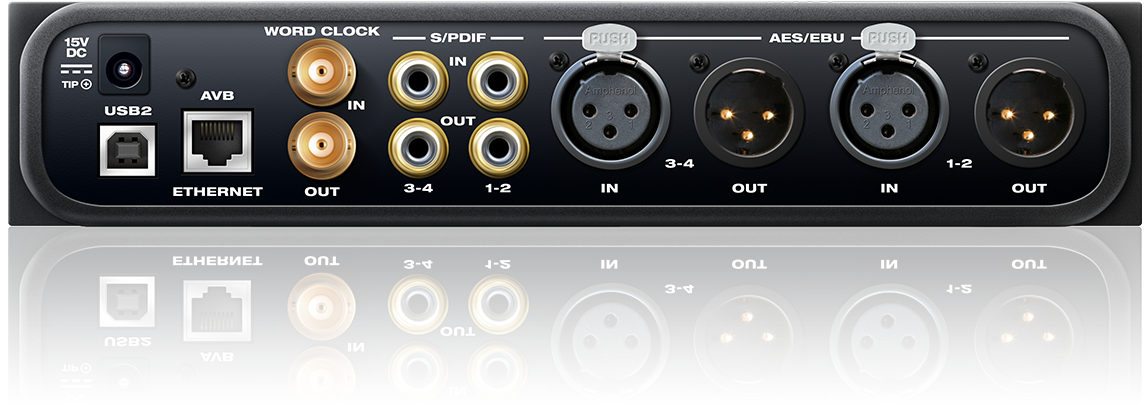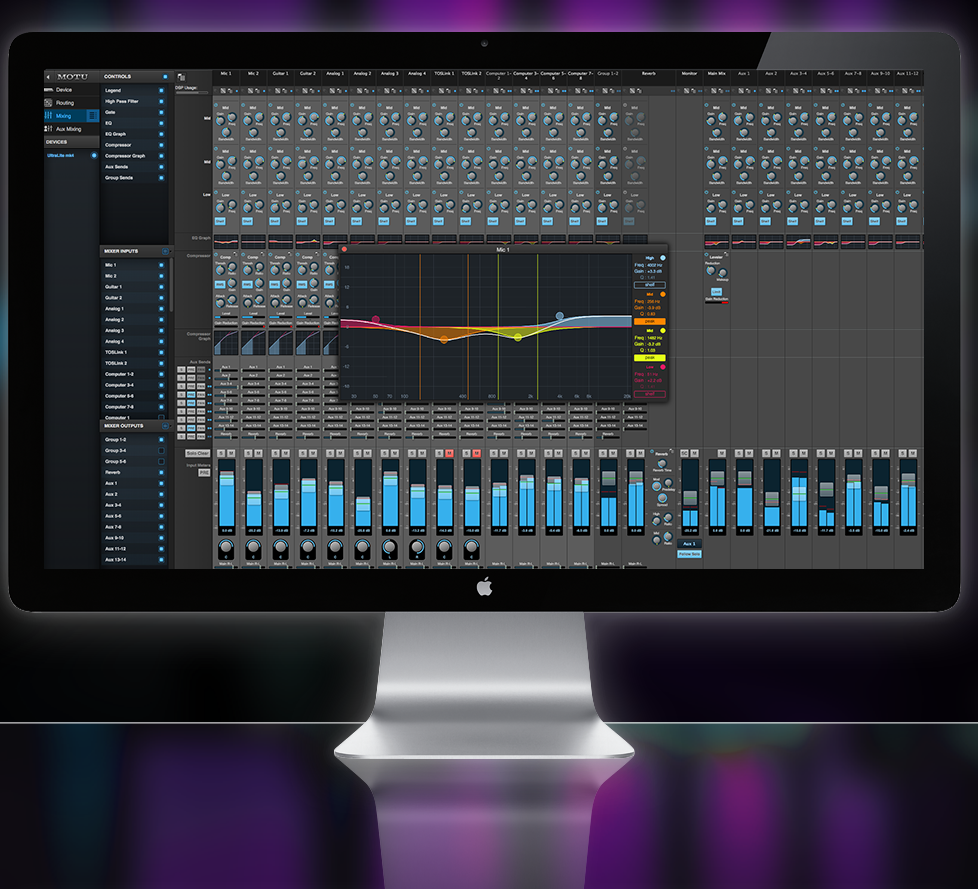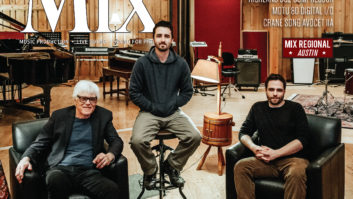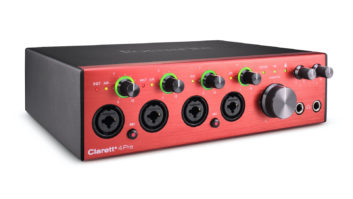The outstanding MOTU 8D fills an important niche unaddressed by other I/O boxes. Featuring no preamps or converters (save for those serving a front-panel stereo headphone jack), the 8D relies solely on digital interfaces for I/O and networking. There are eight channels of AES/EBU (four in and four out), eight channels of S/PDIF, high-speed USB 2.0 (compatible with USB 3.0 and iOS) and AVB-TSN.
With a round-trip latency as low as 1.7 ms, the 8D is a great solution for studios that already have high-quality mic/line preamps and A/D/A converters and just need digital connectivity, without redundant analog front- and back-end circuitry. And using the included 64-channel AVB/TSN Ethernet port (providing 32 ins and 32 outs) and an optional MOTU AVB Switch, users can integrate the 8D into a much larger system of computers and AVB-ready MOTU or third-party I/O boxes, for tracking large ensembles and networking audio throughout a multi-room facility.
But the half-rack 8D is also a great standalone solution for small studios and musicians to use for mixing, mastering, small post-production projects, overdubbing and recording up to eight tracks at once. A variety of clocking schemes allow use of all eight AES/EBU and S/PDIF input channels simultaneously—enough to record either a multi-miked drum kit or guitar, bass, keys and vocals live. A very flexible 48-input virtual mixer (served by the included MOTU Pro Audio Control Web app) provides seven stereo aux buses, three stereo groups, access to 32 network inputs, several audio-analysis tools, and DSP effects (reverb, 4-band EQ, compression and gating), with 32-bit floating processing providing sky-high headroom. The mixer can mix previously recorded tracks from your DAW with live mic/line inputs, and use its aux buses for creating separate headphone mixes for musicians.

On Display
A multicolor LCD on the 8D’s front panel shows level meters for all I/O (including the headphones output, which can monitor any stereo channel pair) and the current sampling rate, clock source and I/O activity over the AVB/TSN port. Pressing buttons to the left of the LCD lets you view the 8D’s current IP address and other network settings and change the clock source and sampling rate. The headphone (TRS) jack and its rotary volume control, and a rocker-style power switch finish off the front panel.
Related: New Products from MOTU, Propellerhead, Mackie and More, by Kevin Becka, Mix, Dec. 14, 2017
The 8D’s rear panel is home to two pairs each of AES/EBU and S/PDIF I/O (on XLR and RCA connectors, respectively), providing eight input and eight output channels; word clock I/O (on BNC jacks); a USB 2 port (up to 64 outputs and 64 inputs to and from a computer); and an AVB/TSN Ethernet port. Signals in any of these digital formats can be converted to another on the trip from input to output.
The AES/EBU and S/PDIF I/O can operate at all standard sampling rates from 44.1 to 192 kHz and feature independent sampling-rate conversion (SRC)—allowing for recording via all 2-channel digital inputs simultaneously, even if the audio sources’ clocks aren’t resolved to the 8D. The Ethernet port alternately provides industry-standard IEEE 802.1 network connectivity to other MOTU AVB-equipped audio interfaces; audio I/O with a Mac fitted with a Thunderbolt port and running OS X v10.11 or later; or connection to a standard Ethernet hub or Wi-Fi router, or to an AVB/TSN Ethernet switch serving a low-latency AVB/TSN audio network. A co-ax power receptacle serves the included external DC power supply.

The excellent MOTU Pro Audio Control Web app (included) provides control of utility, routing and mixing functions, and is served from the 8D’s hardware; it doesn’t reside on your hard drive. There are several ways you can launch the Web app using a computer (Mac or PC), an iPad or iPhone. The app’s virtual mixer can be controlled using any Web browser with a computer, or a tablet or smartphone connected to your local Wi-Fi network. You can use the 8D’s multichannel audio I/O with iOS apps by connecting the interface to your iPad or iPhone using a USB cable and a standard camera connection kit adapter. By the time you read this, a new user interface dubbed Touch Console will have been added to the Web app, providing multitouch mixing optimized for mobile devices.
The app has four different views. The Device tab lets you view and edit utility settings (such as the sampling rate) and recall factory presets for quickly setting up the 8D as a simple interface, a standalone mixer and so on. Click in a matrix of cells in the Routing tab to patch any 8D input to one or more outputs. The Mixing tab provides a comprehensive and flexible virtual mixer. The Aux Mixing tab provides long-throw faders for the aux buses, groups and reverb bus. The Device, Routing and Mixing tabs all let you save and recall custom setups as presets. MOTU’s streamlined, cross-platform AudioDesk 4.0 workstation is also included with the 8D.
Practical Uses
Using the 8D to do in-the-box stereo mixing couldn’t be easier. I executed all level adjustments and signal processing using Digital Performer’s mixer and my third-party Audio Units plug-ins; the app-based mixer and effects processing were not used. I monitored the master bus output via one of the 8D’s AES/EBU outputs. I used a similar approach for stereo mastering, where I patched a couple of the 8D’s 2-channel hardware outputs to separate D/A converters, using them to hear A/B comparisons of mastered and unmastered tracks.

The 8D’s setup for overdubbing was a bit more complicated. I first outputted each track in DP to a different input in the Web app’s mixer, using it to set up a main mix for myself to hear and a separate pre-fader cue mix for the performer. As I preferred to make all fader and pan adjustments for the main mix in DP and use Audio Units plug-ins for processing, I set all the faders for the main mix in the Web app’s mixer to 0 dB, so as not to change the mix coming from DP.
I sent the main mix via the 8D’s AES/EBU 1-2 hardware outputs to a D/A for monitoring. I used the Aux 1 and Aux 2 faders in the Web app’s Aux Mixing tab to set up the stereo cue mix. The Aux 1-2 cue mix was routed via the 8D’s S/PDIF 1-2 outputs simultaneously to two places: the 8D’s headphone output (for my confidence monitoring) and an external D/A serving a multichannel headphone amp for the performer. The external D/A used for the cue mix could also host a talkback mic—something that the 8D, unfortunately, does not provide, though I’m told there will be a firmware update soon.
The live performer’s stereo mic signal was routed through my outboard preamps, compressors and A/D converters to the 8D’s AES/EBU inputs 1 and 2; those hardware inputs were routed simultaneously to DP (to record to new tracks) and to faders in the Web app’s Aux Mixing tab (to add to the performer’s cue mix with zero latency). The 8D’s cited ultra-low round-trip latency is no idle boast: I could process the live track through a Lexicon PCM Native Reverb plug-in in DP and monitor the effect in the 8D’s main and aux mixes without noticing any latency whatsoever. But I also appreciated the convenience of having the Web app’s serviceable reverb and EQ for use on aux mixes.
The 8D’s generous allotment of digital I/O, ultra-low latency, freely assignable routing, sampling rate and format conversion, AVB/TSN networking, flexible virtual mixer and low price add up to a package that can’t be beat. I’m buying!
Michael Cooper ([email protected]) is a recording, mix, mastering and post-production engineer and a contributing editor for Mix magazine.







